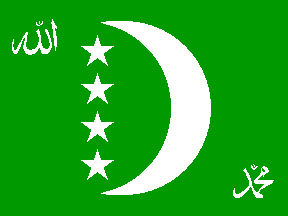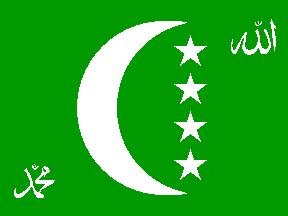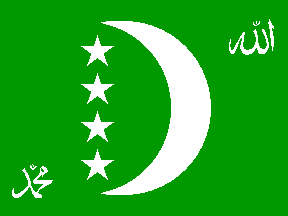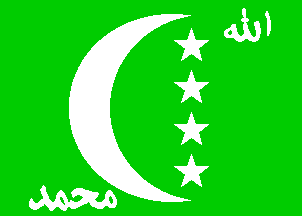
image by Arnaud Palac and António Martins,
25 Jan 2000 |

Last modified: 2016-03-10 by bruce berry
Keywords: comoros |
Links: FOTW homepage |
search |
disclaimer and copyright |
write us |
mirrors
There is quite a variety of objects [regarded as the
national flag] hanging from flagpoles in the country.
Iain Walker, 10 Feb 1999
I just got back from the Comoros where I made a
point of inspecting the flags. There are at least
three varieties flying [two shown on this page and
the third, most recent and official, at the
main 1996-2001 page]. I
could not find the presidential
decree in the national archives, it seems to
have been “lost”. On all flags
the crescent and four stars are as we know, upright
and open to the fly. It’s the text that moves,
although the actual text itself is the same: Allah
(اللّه) and Mohammed
(مهمّد), both with
shahadas (little "w"s), but no other diacritics.
I didn’t manage to actually measure any, but these
old dark green varieties are probably slightly
squarer than 3:4
Iain Walker, 21 Dec 1999 and 14 Jan 2000
The sides are different because the writing must be
correct in both sides (thus differentially inverted) and
the moon must point to the fly in both sides (thus not
inverted), I believe.
António Martins, 08 Nov 1998
 image by Arnaud Palac and António Martins, 25 Jan 2000 | |
Flag 1 (the oldest): obverse (face showing when
the pole is at the viewer’s right hand), Allah
(اللّه), top, in the
fly, Mohammed, bottom, hoist; reverse (face showing when
the pole is at the viewer’s left hand), Allah, top, in
the fly, Mohammed (مهمّد),
bottom, hoist.
Iain Walker, 21 Dec 1999
 by Arnaud Palac and António Martins, 25 Jan 2000 | |
Calvarin [clv02]
shows a flag similar to this one.
Ivan Sache, 20 Apr 2002
 image by Arnaud Palac and António Martins, 25 Jan 2000 | |
Flag 2: obverse (face showing when the
pole is at the viewer’s right hand), Allah
(اللّه), top, in the
hoist, Mohammed (مهمّد),
bottom, in the fly; reverse (face showing when the
pole is at the viewer’s left hand), Allah, top, in the
fly, Mohammed, bottom, hoist.
Iain Walker, 21 Dec 1999
Album 2000 [pie90] shows this design.
Željko Heimer, 15 Jan 2002
 by Arnaud Palac and António Martins, 25 Jan 2000 | |
 by Jos Poels and Mark Sensen, 05 Apr 1997 | |
The flags at the Sydney Olympics were made by the USA subsidiary of
Doublet. The form of Comoros flag used was the design as supplied by
Paramount Flags — which naturally enough followed the Flag Research
Centre version of the design. A Flag
Bulletin article [smi97b]
(No. 174 (March 1997) shows the design with the name "Muhammad"
(مهمّد) in a single line and "Allah" in
a different lettering.
Ralph Kelly, 22 Dec 2000
The design in [smi97b] was used
by Annin to make the Comoros flags for outside the United Nations. When the
Comoron Ambassador to the UN saw it he rejected it as having the wrong
inscription on it. The words "Allah" (اللّه)
and "Mohammed" (مهمّد) are meant to be the
traditional ullams or monograms rather than the names written out in
full. The Comoron government supplied a sample flag which Annin used to make
replacement flags.
Graham Bartram, 23 Dec 2000
Lux-Wurm [lux01] shows the incorrect
version from [smi97b].
Ivan Sache, 20 Apr 2002
The flags originally flown at the UN after
the new flag was announced, had "Muhammed" written out in “long hand”,
as was shown in [smi97b].
The actual flag doesn’t use “long hand” but
the more stylized ulam (a sort of monogram). Arabic calligraphy is
very flexible and forms a major part of Arabic art and the ulams have
developed as a stylized form of the names. If you look at the flag of
Saudi Arabia it quickly becomes apparent that
the Shahada is not just written across it in everyday writing, but has
been drawn in a complex and beautiful pattern.
Since the design approved by the Comoros government specifically used
ulams and not everyday script they felt it was inappropriate for
the flag outside the UN to have the wrong type of calligraphy. They sent
an actual flag to the UN which was then used by Annin & Co to make
replacement flags for UN use.
(Another example of stylized Arabic calligraphy can be found in the
flag of Iran: the swords write out Allah, and
the edge pattern says "Allah u ahkbar").
Graham Bartram, 23 Sep 1999